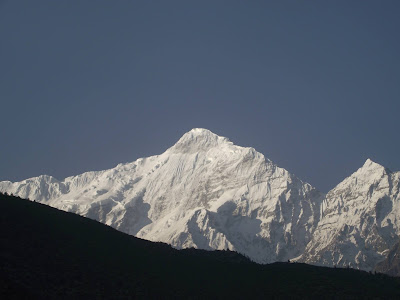The silent dark waters of the Kaligandaki, the majestic view of the Nilgiri mountain, a stone paved path passing through lush green trees and shrubs near the river banks and arid, dry hills where nothing seems to grow, the shivering cold mountain breeze and the scorching hot sun makes Jomsom a haven for anyone wanting to enjoy nature at its best.

Jomson, the capital of the forbidden kingdom from where Nilgiri Mountain looks like vanilla ice cream just waiting to be relished, is also a pilgrim’s gateway to the holy Muktinath Chhetra. "It is believed that not just anyone can visit Muktinath, only a blessed few make it there," said Nabin Rana, A police officer stationed at Jomson.
The stone paved path leads us past the Jomson Bazaar to a small jeep station where jeeps to Ranipauwa can be hired. Just one and half hour jeep ride through the dry and arid Kaligandaki plains, Kagbeni and its verdant vegetation, past the treacherously creepy dry hills and cliffs and the strong winds that can practically blow you off your feet--brings you to the sunny Muktinath valley. Nestled in the foothills of the Thorong-La pass at an altitude of 3,750 meters, lies every Hindu pilgrims’ passport to heaven---Muktinath.

Muktinath or Chumig Gyatsa as the locals call it is an important holy shrine for both the Hindus and the Buddhists. For centuries, it has been the centre of our beliefs and a melting pot for Hinduism and Buddhism, where the two religions bond creating peace, tranquility and harmony, a miraculous place where even at such high altitudes trees grow making it an abode for meditation.
For Buddhists it is the home of Dakinis or goddesses known as sky dancers and it is one of their most important tantric shrines. They also believe that it is here the great Padamsambhava who is known to be the founder of Tibetan Buddhism meditated while he was on his way to Tibet.

This is probably the only Hindu temple, which is cared for by Buddhist nuns, where prayers are performed not by a Hindu priest but a Buddhist priest. One can only enter the holy temple after bathing in the 108 ice-cold waterspouts and dipping into, two freezing cold ponds right in front of the temple.
It’s not just pilgrims that attempt bathing in the icy cold waters but every visitor wants to get wet after the 20 minute walk from Rani Pauwa to the pilgrimage in the scorching hot sun.
After the freezing cold bath, which supposedly cleanses off all your sins, you are allowed
to enter the temple and pay homage to the gods---Lord Vishnu and the two goddess Laxmi and Saraswati.
 |
| Jwalamai temple at Muktinath |
Muktinath, is also known as the only place on earth where you can find all five elements
from which everything is made water, fire, earth, air and sky coming together in their own distinct form. The Jwala Mai temple situated near the Muktinath temple is where all these elements come together to form the eternal flame that lies on top of water. This flame according to the locals there is believed to have been lit by Lord Brahma when he conducted the first universal prayer.
It is also believed that the Muktinath stream which descends and submerges into the
Kaligandaki is known to be the source of all shillas and Shaligrams which are actually fossil stones that are supposedly an incarnation of Lord Vishnu according to the Hindu mythology.
"Lord Vishnu takes up various forms and avatars and Shaligram is one of them," said Sano Gurung who sells Shaligrams and other souvenirs at Muktinath. He also informed that one such stone can cost from Rs.150 to over a thousand rupees.
 |
| Shaligram from the Kaligandaki River |
The pilgrimage is extremely popular among followers of both the religions and approximately 300 hundred people are believed to visit the temple every day, however the management there does not have exact data on the number of pilgrims coming there.
"For us South Indians Muktinath is as important as Tirupati," said Kulasigaram a pilgrim who was there with his relatives.
According to their beliefs, Lord Vishnu supposedly attained enlightment here. "Out of the108 pilgrimages Muktinath is considered to be the 78th most important pilgrimage for us," he said.
The South Indian pilgrims however complained about how difficult it was to get there and stated that it would make it a lot easier for them if helicopter services from Pokhara to Muktinath resumed. "We are traveling with old people, its really difficult for old people above the age of sixty to travel this way," he and his friends added and informed that their team consisted of mainly old aged people above the age of 65.
Traveling to Muktinath makes one realize that peace is not impossible and despite our differences, we can still live peacefully so long as we have mutual respect for each other. Muktinath is truly a great example of how two religions can share the same holy pilgrimage with mutual respect and support.
Comments
Post a Comment